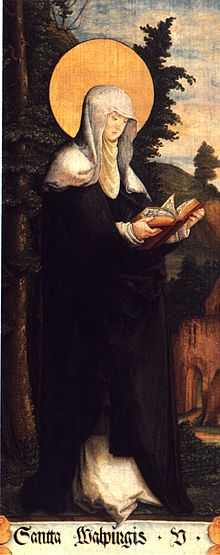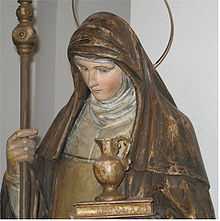Saint Walpurga
| Saint Walpurga | |
|---|---|
 Painting by the Master of Meßkirch, c. 1535-40. | |
| Born |
c. 710 Devon |
| Died |
25 February 777 or 779 Heidenheim (Mittelfranken) |
| Canonized | 870 by Adrian II |
| Feast | Varies |
| Patronage | Eichstätt, Antwerp and other towns |
Saint Walpurga or Walburga (Old English: Wealdburg; c. 710 – 25 February 777 or 779), also spelled Valderburg or Guibor,[1] was an English missionary to the Frankish Empire. She was canonized on 1 May ca. 870 by Pope Adrian II. Walpurgis Night (or "Walpugisnacht") is the name for the eve of her day, which coincides with May Day.
Life
Walpurga was born in Devonshire, England of a family of the local aristocracy. She was the daughter of St. Richard the Pilgrim, one of the under-kings of the West Saxons, and of Winna, sister of St. Boniface, Apostle of Germany, and had two brothers, St. Willibald and St. Winibald. He is buried in the Basilica of San Frediano, Lucca, where he died on pilgrimage in 722. Saint Richard is also known the Richard the Saxon Pilgrim, of Droitwich.
St. Richard, when starting with his two sons on a pilgrimage to the Holy Land, entrusted Walburga, then eleven years old, to the abbess of Wimborne.[2] Walpurga was educated by the nuns of Wimborne Abbey, Dorset,[3] where she spent twenty-six years as a member of the community.[2] She then travelled with her brothers, Saints Willibald and Winibald (Winebald), to Francia (now Württemberg and Franconia) to assist Saint Boniface, her mother's brother, in evangelizing among the still-pagan Germans. Because of her rigorous training, she was able to write her brother Winibald's vita and an account in Latin of his travels in Palestine. As a result, she is often called the first female author of both England and Germany.[2]
Walpurga became a nun in the double monastery of Heidenheim am Hahnenkamm, which was founded by her brother, Willibald, who appointed her as his successor. Following his death in 751, she became the abbess.[3] Walpurga died on 25 February in either 777 or 779 (the records are unclear) and was buried at Heidenheim; the day carries her name in the Catholic church calendar. In the 870s, Walpurga's remains were transferred to Eichstätt. In Finland, Sweden, and Bavaria, her feast day commemorates the transfer of her relics on 1 May.
Veneration

Walpurga's feast day is on 25 February, but the day of her canonization, 1 May (possibly in AD 870), was also celebrated during the high medieval period, especially in the 11th century under Anno II, Archbishop of Cologne, so that Walpurgis Night is the eve of May Day, celebrated in continental folklore with dancing.
At Eichstätt, her bones were placed in a rocky niche, which allegedly began to exude a miraculously therapeutic oil, which drew pilgrims to her shrine.
The two earliest miracle narratives of Walpurga are the Miracula S. Walburgae Manheimensis by Wolfhard von Herrieden, datable to 895 or 896, and the late tenth-century Vita secunda linked with the name of Aselbod, bishop of Utrecht. In the fourteenth-century, Vita S. Walburgae of Phillipp von Rathsamhaüsen, bishop of Eichstätt (1306–22) the miracle of the tempest-tossed boat is introduced, which Peter Paul Rubens painted in 1610 for the altarpiece for the church of S. Walpurgis, Antwerp.[4]

The earliest representation of Walpurga, in the early 11th-century Hitda Codex, made in Cologne, depicts her holding stylized stalks of grain. In other depictions the object has been called a palm branch, which is not correct, since Walpurga was not martyred. The grain attribute has been interpreted as an occasion where a Christian saint (Walpurga) came to represent the older pagan concept of the Grain Mother. Peasant farmers fashioned her replica in a corn dolly at harvest time and told tales to explain Saint Walpurga's presence in the grain sheaf.[5]
The Church of St. Walburge, Preston, a Roman Catholic church in Preston, Lancashire, England, is a tall and beautiful church dedicated to her. The church is famous as having the tallest spire of any parish church in England.
Patronage
Walpurga is the patroness of Eichstadt, Oudenarde, Furnes, Antwerp, Weilburg, and Zutphen, and is invoked as special patroness against hydrophobia, and in storms, and also by sailors.[2]
Legacy
St. Walburga's Abbey is located at Eichsmett. Bavaria. A second Benedictine Abbey of St. Walburga is located in Virginia Dale, Colorado, near the Wyoming border. The abbey is home to approximately 20 contemplative Catholic nuns and also has a retreat center.[3]
At 309 ft., the spire of St Walburge's Roman Catholic Church in Preston is the tallest of any parish church in England with only the spires of Salisbury and Norwich Anglican Cathedrals reaching higher.[6]
See also
- Germanic Christianity
- Walpurgis
Notes
- ↑ Other spellings: Valborg (the Swedish name for her), Walburge, Valpuri, Auboué, Avangour, Avongourg, Falbourg, Gaubourg, Gualbourg, Valburg, Valpurge, Vaubouer, Vaubourg, Walbourg, Walpurd, Warpurg. She is also known by the seemingly unrelated names Perche and Eucharis.
- ↑ 2.0 2.1 2.2 2.3 Casanova, Gertrude. "St. Walburga." The Catholic Encyclopedia. Vol. 15. New York: Robert Appleton Company, 1912. 18 May 2013
- ↑ 3.0 3.1 3.2 Abbey of St. Walburga
- ↑ the altarpiece is now disassembled. Susanne Heiland, "Two Rubens Paintings Rehabilitated" The Burlington Magazine, 111 No. 796 (July 1969:421-427) p.
- ↑ Pamela Berger, The Goddess Obscured: Transformation of the Grain Protectress from Goddess to Saint, 1985:61-64, gives several examples and bibliographical notes.
- ↑ Morgan, Ann. "Local landmarks: St Walburge's", BBC, 15 August 2008
| Wikimedia Commons has media related to Saint Walpurga. |
| Wikisource has the text of the 1885–1900 Dictionary of National Biography's article about Walburga. |